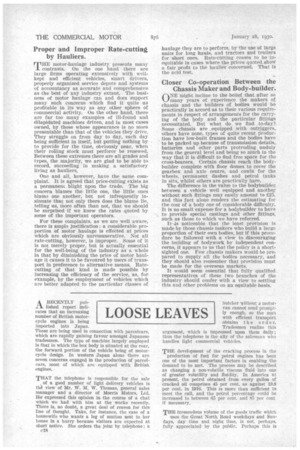Proper and Improper Rate-cutting by Hauliers.
Page 40

If you've noticed an error in this article please click here to report it so we can fix it.
THE motor-haulage industry presents many contrasts. On the one hand there • are large firms operating extensively with wellkept and efficient vehicles, smart drivers, properly organized service depots and systems of accountancy as. accurate and comprehensive as the best of any industry extant. The business of motor haulage can and does support many such concerns which find it quite as profitable in its way as any other sphere of commercial activity. On the other hand, there are far too many examples of ill-found and dilapidated machines driven, and in most cases owned, by those whose appearance is no more presentable than that of the vehicles they drive. They struggle on from day to day, each day being sufficient in itself, but putting nothing by to provide for the time, obviously near, when their rolling stock must perforce be renewed. Between these extremes there are all grades and types, the majority, we are glad to be able to record, succeeding in making a satisfactory living as hauliers.
One and all, however, have the same complaint. It is agreed that price-cutting exists as a permanent blight upon the trade. The big concern blames the little one, the little ones blame one another, but not infrequently insinuate that not only there. does the blame lie, telling us, more often than not, that we should be surprised if we knew the rates quoted by some of the important operators.
For these complaints, as we are well aware, there is ample justification : a considerable proportion of motor haulage is effe'Cted at prices which are obviously unremunerative. Not all rate-cutting, however, is improper. Some of it is not merely proper, but is actually essential for the well-being of the industry as a whole in that by diminishing the price of motor haulage it causes it to be favoured by users of transport in preference to alternative means. Ratecutting of that kind is made possible by increasing the efficiency of the service, as, for example, by the employment of vehicles which are better adapted to the particular classes of • haulage they are to perform, by the use• of large units for long hauls, and tractors and trailers for short ones. Rate-cutting ceases to be Inequitable in cases where the prices quoted show a fair profit to the haulier concerned. That is the acid test.
Closer Co-operation Between the Chassis Maker and Body-builder. • •
NE might incline to the belief that .after _so V/ many years of experience the makers of chassis and the builders of bodies would be practically in accord as to their various requirements in respect of arrangements for the carrying of the body , and the particular fittings necessitated. But what do we find to-day? Some chassis are equipped with outriggers, others have none, types of quite recent production have low-built frames and the bodies have to be packed up because of transmission details, batteries and other parts protruding unduly from the general level and being so Much in the way that it is difficult to find free space for the cross-bearers. Certain chassis reach the bOdybuilder complete with floor domes to cover the gearbox and axle centre, and cowls for the wheels, permanent dashes and petrol tanks
in situ, whilst others are practically bare. ,
The difference in the value to the bodybuilder between a vehicle well equipped and another without such fittings may easily amount to £25, and this fact alone renders the estimating for the cost of a body one of considerable difficulty. It is no small expense for a bodybuilder to have to provide special castings and other fittings, such as those to which we have referred.
It-s noticeable that the least provision is made by those chassis makers who build a large proportion of their own bodies, but if this procedure be followed with a view to discouraging the building of bodywork by independent concerns, it appears to us that the policy is a shortsighted one. Few chassis makers would be pre, pared to supply all the bodies necessary, and they should also rernember that provision must be made for the overseas markets. It would seem essential that fully qualified. representatives of these two branches of the industry should confer with a view to settling this and other problems on an equitable basis.












































































































